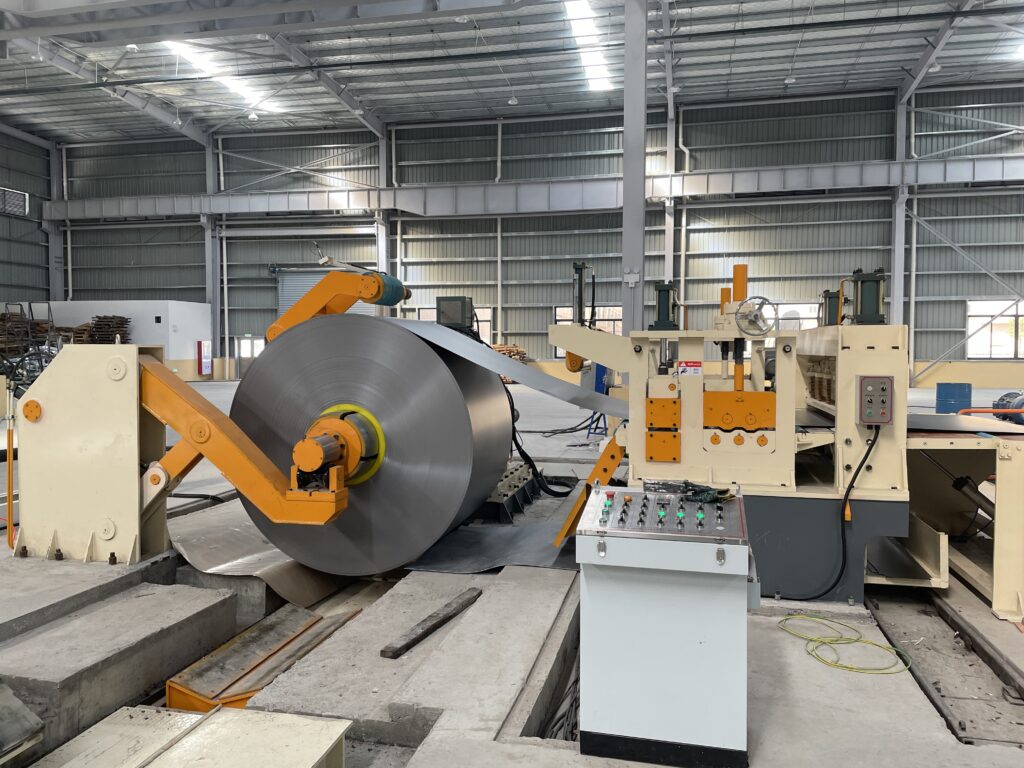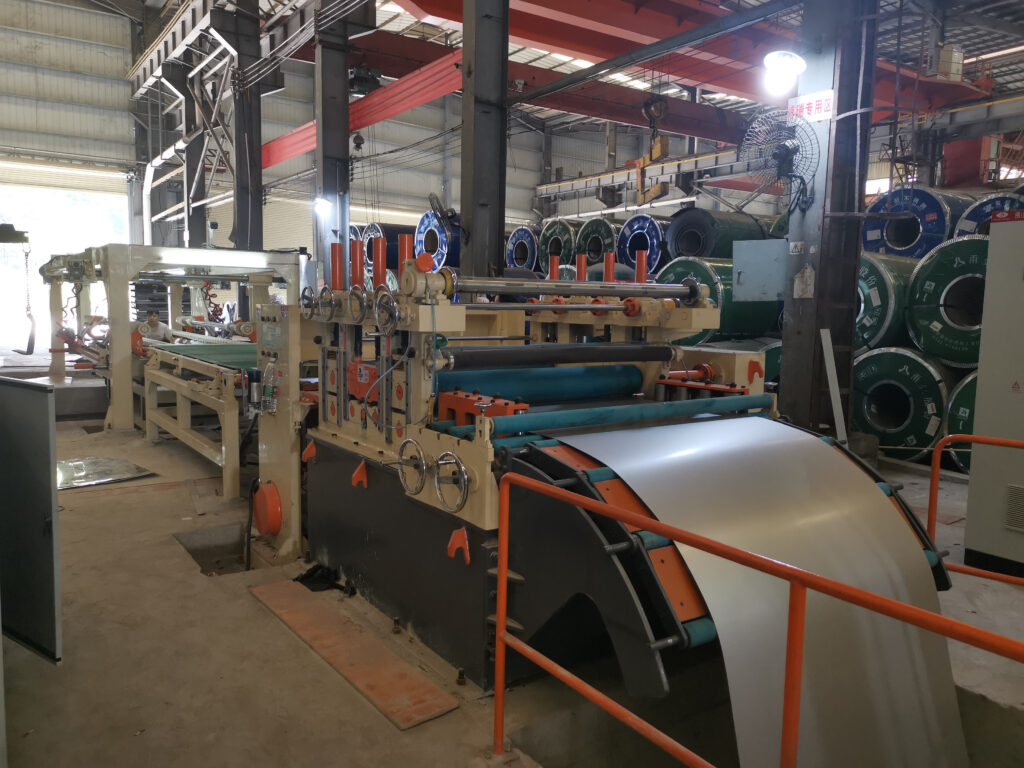How Slitting Lines Maximize Material Yield and Reduce Scrap
The key mechanisms include controlled knife clearances (typically 5-8% of material thickness), multi-zone tension management systems, and automated setup procedures that minimize material waste during changeovers.
In modern metal processing, material waste continues to be a critical factor influencing overall profitability. Industry developments in 2025 reveal that advanced slitting line systems can significantly diminish scrap rates by over 40%, translating into substantial cost savings for facilities handling large volumes of raw materials . Cutting-edge solutions, such as servo-controlled blade positioning systems that maintain tolerances within ±0.1mm, have revolutionized precision cutting, drastically reducing edge trim and material loss. Meanwhile, servo-driven tension control mechanisms effectively eliminate issues like camber and coil deformation, ensuring superior flatness and enabling maximum coil utilization.
Furthermore, case studies from leading manufacturers employing sophisticated coil nesting algorithms illustrate that material yields routinely exceed 97%, representing a considerable improvement over traditional practices where scrap rates hover between 15-20%. This leap in efficiency is driven by ongoing innovations in sensor accuracy, automation, and predictive maintenance, all vital in meeting the heightened demands for precision and cost-effectiveness in 2025. Companies like Maxdo Machine exemplify these advancements, with their MD series slitting lines delivering measurable savings, enhanced process stability, and industry-leading performance standards.
The Hidden Economics of Material Loss
Material costs consume 60-80% of total production expenses in most metal processing facilities. This makes yield optimization not just an operational concern, but a strategic imperative for maintaining competitive positioning in increasingly price-sensitive markets.
Primary waste mechanisms create predictable loss patterns that engineering solutions can systematically address. Edge trim requirements represent the single largest source of material loss, historically demanding 3-5% of total coil width to accommodate dimensional variations. Width tolerance deviations force manufacturers to specify additional material beyond actual requirements, reducing effective yield by an additional 5-15%.
Camber and bow defects compound these losses. When internal stresses in metal coils create curved strips instead of straight ones, affected sections become unsuitable for precision applications. This forces costly downgrading or complete rejection of material that met thickness and width specifications but failed dimensional straightness requirements.
Setup and changeover operations add another 2-8% to material consumption, particularly in facilities processing diverse product mixes. The cumulative effect creates a cascade of waste that transforms profitable operations into marginal ones.
Engineering Principles Behind Precision Yield Control
Blade geometry and positioning form the foundation of effective yield optimization. Contemporary slitting operations utilize circular knife systems with servo-driven positioning that maintains precise clearances throughout extended production runs. Research conducted at leading metallurgical institutes demonstrates optimal blade penetration ranges from 8-12% of material thickness, with side clearances maintained at 5-8% of thickness.

This precision prevents the gradual quality degradation that plagues traditional fixed-clearance systems. Dynamic clearance control automatically adjusts cutting parameters as material properties vary within individual coils, maintaining consistent edge quality that eliminates downstream rejection.
Multi-zone tension management represents another critical engineering advancement. Modern systems monitor and control tension in real-time across entry, cutting, and exit zones with millisecond response capabilities. This prevents the camber defects that can render 10-20% of processed strips unusable for precision applications.
Servo-driven dancer roll systems provide instantaneous response to material property variations, coil diameter changes, and processing speed adjustments. Unlike conventional pneumatic systems that react slowly to changing conditions, servo control eliminates the tension spikes and variations that cause dimensional inconsistencies and edge damage.
Advanced Equipment Architecture for Maximum Efficiency
Contemporary slitting lines integrate decoiling, leveling, slitting, and recoiling functions through centralized servo control that optimizes material flow throughout the entire process. This integration eliminates handoff points where material damage and dimensional variations typically occur in segmented systems.
The MD-850 precision slitting line exemplifies this integrated approach. Processing materials from 300-820mm width and 0.3-12mm thickness, the system maintains ±0.1mm cutting precision through servo-driven blade positioning and real-time process monitoring. Total power consumption of 138.5kW supports processing speeds up to 250m/min while maintaining energy efficiency standards.
Precision leveling systems remove coil set and material stress before slitting operations begin. Multi-roll leveling configurations reduce material stress variations by 85-90% compared to unleveled material, directly improving cutting accuracy and final product quality.
For wider material processing requirements, the MD-1650MM industrial system extends capabilities to 1600mm working width while maintaining identical precision standards. Customizable weight configurations from 10-35 tons allow optimization for specific material types and processing requirements.
Real-World Implementation: Case Study Analysis
Automotive supplier optimization project: A major automotive parts manufacturer processing 15,000 tons annually of galvanized steel achieved 12% yield improvement through systematic slitting line upgrade. Prior operations utilizing conventional equipment averaged 82% material utilization due to excessive edge trim requirements and frequent camber-related rejections.

Implementation of servo-controlled slitting technology with integrated quality monitoring reduced edge trim from 4.2% to 1.8% of coil width. Camber-related rejections dropped from 8% to under 2% through precision tension control. Combined improvements generated $1.6 million annual cost savings with 18-month payback on equipment investment.
Steel service center transformation: A regional steel service center processing diverse material types achieved 18% improvement in overall equipment effectiveness through comprehensive slitting vs CTL line optimization. The facility’s analysis of processing patterns revealed that 65% of orders could be more efficiently processed through optimized slitting rather than cut-to-length operations.
Material yield improvements combined with reduced setup times and improved processing flexibility enabled the facility to reduce inventory requirements by 25% while improving order fulfillment rates by 35%.
Quality Control Integration and Process Monitoring
Real-time measurement systems monitor dimensional accuracy continuously throughout production runs, enabling immediate process adjustments to maintain specifications. Laser-based measurement systems achieve accuracy within ±0.01mm, supporting the tight tolerance control necessary for minimal edge trim processing.
Statistical process control integration tracks yield performance metrics automatically, identifying trends that indicate developing problems before they significantly impact material utilization. This proactive approach prevents the gradual quality degradation that can reduce yield over time.
Edge quality inspection systems identify cutting defects before they result in material rejection, allowing process corrections that prevent continued production of substandard material. Automated inspection reduces quality-related waste by 40-60% compared to manual inspection methods that detect problems only after significant material loss has occurred.
Material-Specific Optimization Strategies
Stainless steel processing demands specialized blade configurations and tension control parameters due to the material’s work-hardening characteristics. The choosing between slitting processing methods for stainless steel applications requires understanding how different alloy compositions affect cutting forces and edge quality requirements.
Austenitic stainless grades typically require 15-20% higher cutting forces than carbon steel equivalents, necessitating more robust blade mounting systems and enhanced vibration damping. Proper blade geometry selection can reduce edge work-hardening by 40-60%, improving subsequent forming operations and reducing customer complaints.
Aluminum processing presents unique challenges related to material adhesion and edge quality. Aluminum’s tendency to build up on cutting edges requires specialized blade coatings and more frequent cleaning cycles. However, aluminum’s excellent ductility enables tighter cutting tolerances, potentially reducing edge trim requirements by an additional 0.5-1.0% compared to steel processing.
Carbon steel optimization benefits from the material’s consistent cutting characteristics but requires careful attention to coating preservation during slitting operations. Galvanized coatings demand specific blade geometries and cutting speeds to prevent coating damage that could affect corrosion resistance in final applications.
Technology Integration and Industry 4.0 Implementation
Predictive maintenance systems utilize sensor data and machine learning algorithms to optimize maintenance timing, ensuring peak performance throughout equipment lifecycles. Vibration analysis, temperature monitoring, and cutting force measurement provide early warning of blade wear, bearing degradation, and alignment issues that affect processing accuracy.
Real-time process optimization through AI-driven parameter adjustment maintains optimal processing conditions automatically as material properties vary throughout production runs. This eliminates manual adjustments that can create temporary yield reductions during process changes.
Supply chain integration enables better coordination between material procurement and processing optimization. When purchasing decisions align with processing capabilities, facilities can maximize yield potential through optimal coil dimension selection and material property matching.
The MaxdoMachine MD series specifications demonstrate how modern equipment design supports Industry 4.0 integration through comprehensive sensor packages, ethernet connectivity, and standardized communication protocols that enable seamless data exchange with enterprise resource planning systems.
Performance Measurement and Continuous Improvement
Material yield percentage provides the comprehensive metric needed to evaluate overall processing effectiveness. Leading facilities consistently achieve yields exceeding 97% through systematic optimization efforts that address each component of material loss.
Trim loss percentage tracking focuses specifically on edge waste relative to total coil width, with optimization targets typically maintaining trim under 2% of coil width through precise cutting and minimal allowance processing.
Setup efficiency metrics measure material consumed during changeovers and quality verification procedures, supporting efforts to minimize transition waste through improved procedures and automation.
Continuous improvement implementation requires systematic analysis of yield data, quality metrics, and processing parameters. Data-driven improvement processes typically generate 2-4% additional yield gains annually through incremental optimizations that compound over time.
Regular performance reviews identify optimization opportunities through trend analysis and correlation studies. Facilities implementing comprehensive yield improvement programs typically achieve cost reductions of 8-15% while improving product quality and delivery consistency.
Return on Investment Analysis and Implementation Planning
Equipment upgrade evaluation must consider both immediate yield improvements and long-term operational benefits. Modern slitting technology typically provides 18-24 month payback periods through direct material savings, with additional benefits from improved quality consistency, reduced maintenance requirements, and enhanced processing flexibility.
Implementation methodology begins with comprehensive material flow analysis to identify specific waste sources and quantify improvement opportunities. Baseline establishment through detailed yield tracking enables accurate measurement of improvement results and supports investment justification.
Cutting pattern optimization utilizes mathematical algorithms to determine the most efficient arrangement of strip widths within available coil width. Systematic pattern optimization improves material yield by 3-5% while reducing setup complexity and changeover time.
For facilities evaluating equipment options, the MD series product certifications provide assurance of compliance with international safety and quality standards while supporting equipment financing and insurance requirements.
Future-Proofing Through Advanced Technology Adoption
The integration of advanced vision systems in slitting lines has transformed real-time surface quality monitoring, allowing manufacturers to identify imperfections as small as 0.1mm even at processing speeds exceeding 200 meters per minute. This capability not only prevents material loss caused by surface defects but also enables automatic adjustment of cutting parameters to sustain optimal yield. Coupled with robust data analytics platforms, operators can continuously analyze process data, uncovering actionable insights that drive yield improvements and operational efficiency over time. Machine learning algorithms now facilitate predictive optimization of settings for new material types, leveraging vast historical datasets to tailor the process precisely.
Automation has further eliminated human variability in setup and operation, resulting in consistently high yields and greatly reduced setup scrap. Leading facilities have demonstrated yield improvements from traditional 80-85% levels to above 97% material utilization, showcasing the profound impact of integrating precision equipment with continuous process optimization programs. With material costs accounting for up to 80% of production expenses, even marginal yield gains translate directly into bottom-line enhancements. Maxdo Machine’s MD series exemplifies this blend of precision engineering and smart automation, delivering measurable efficiency, reduced scrap, and sustainable profitability in today’s competitive metal processing environment. For tailored solutions and comprehensive yield optimization, engaging Maxdo’s expert engineering team ensures equipment and process configurations that align perfectly with your operational goals.




